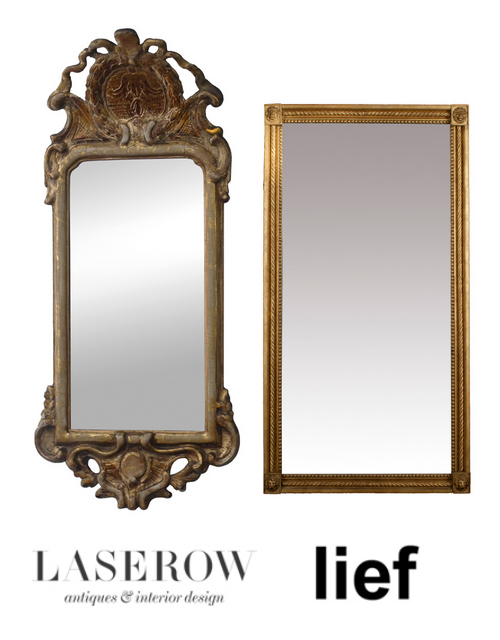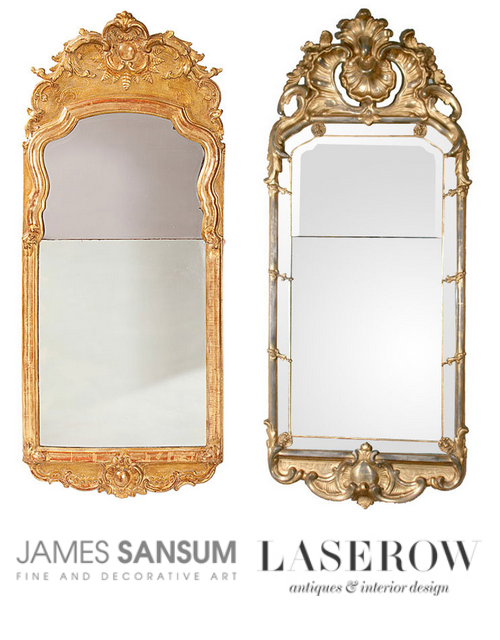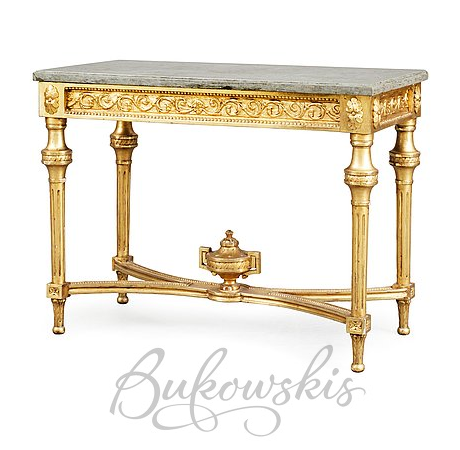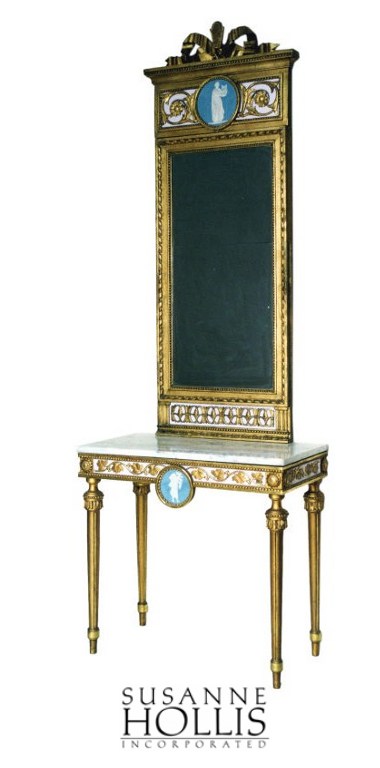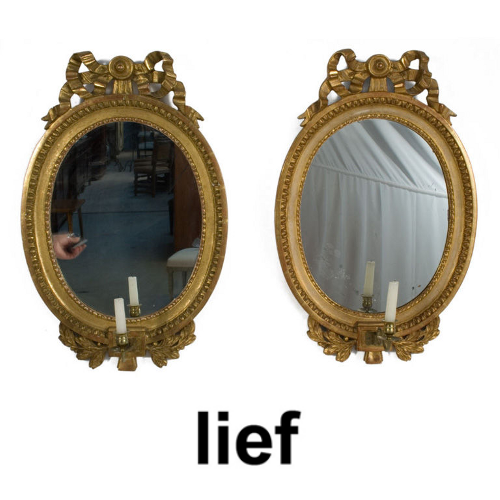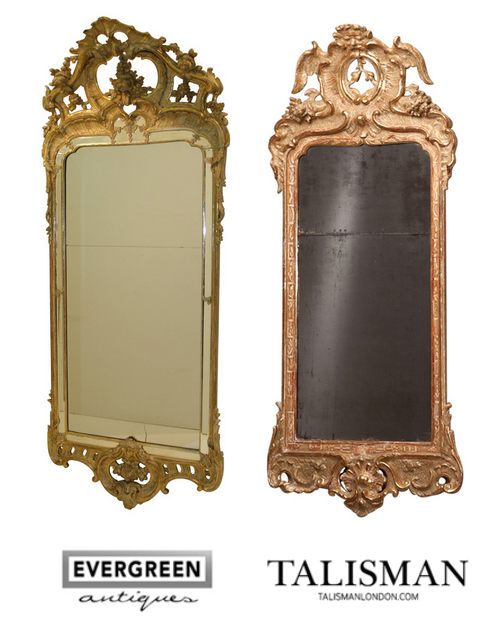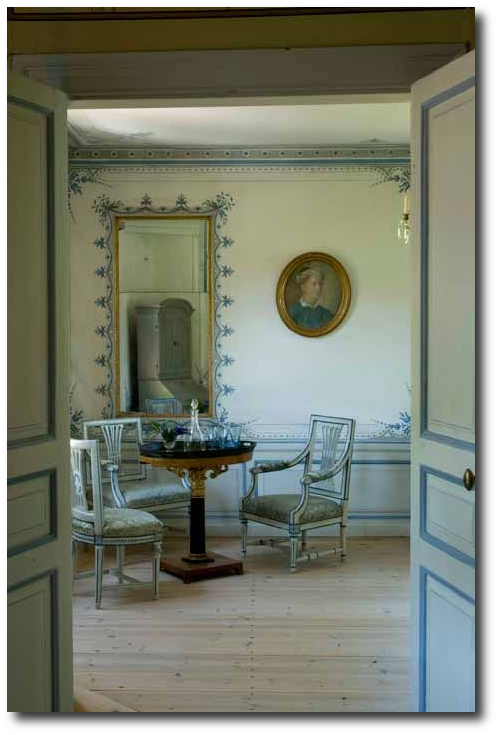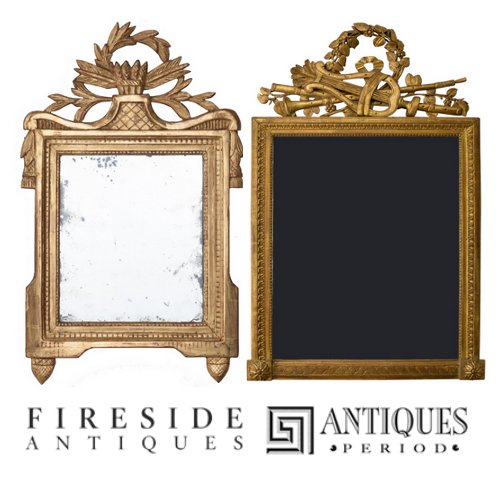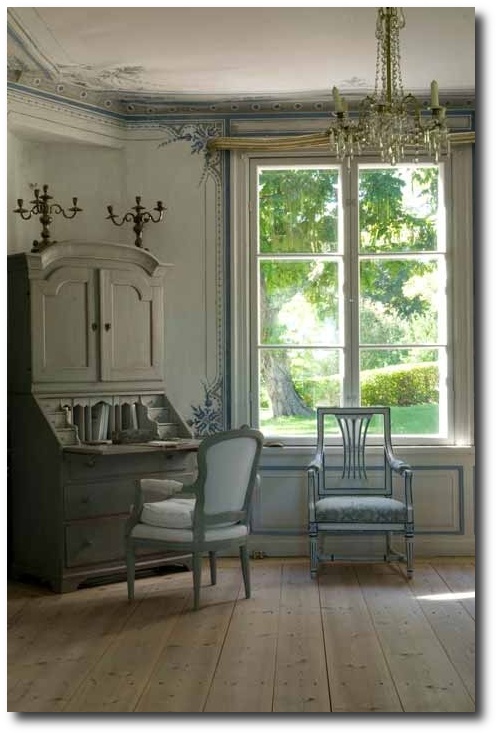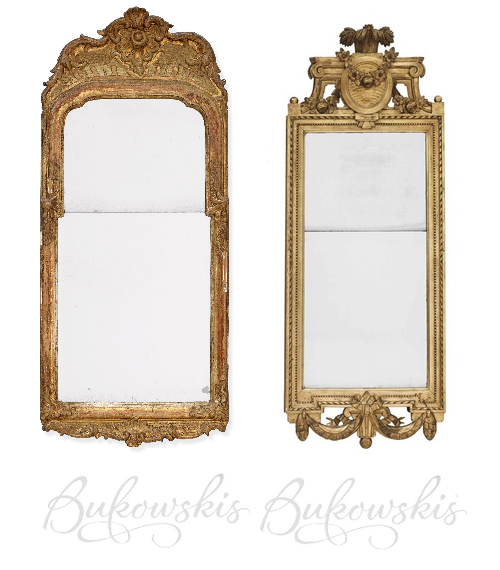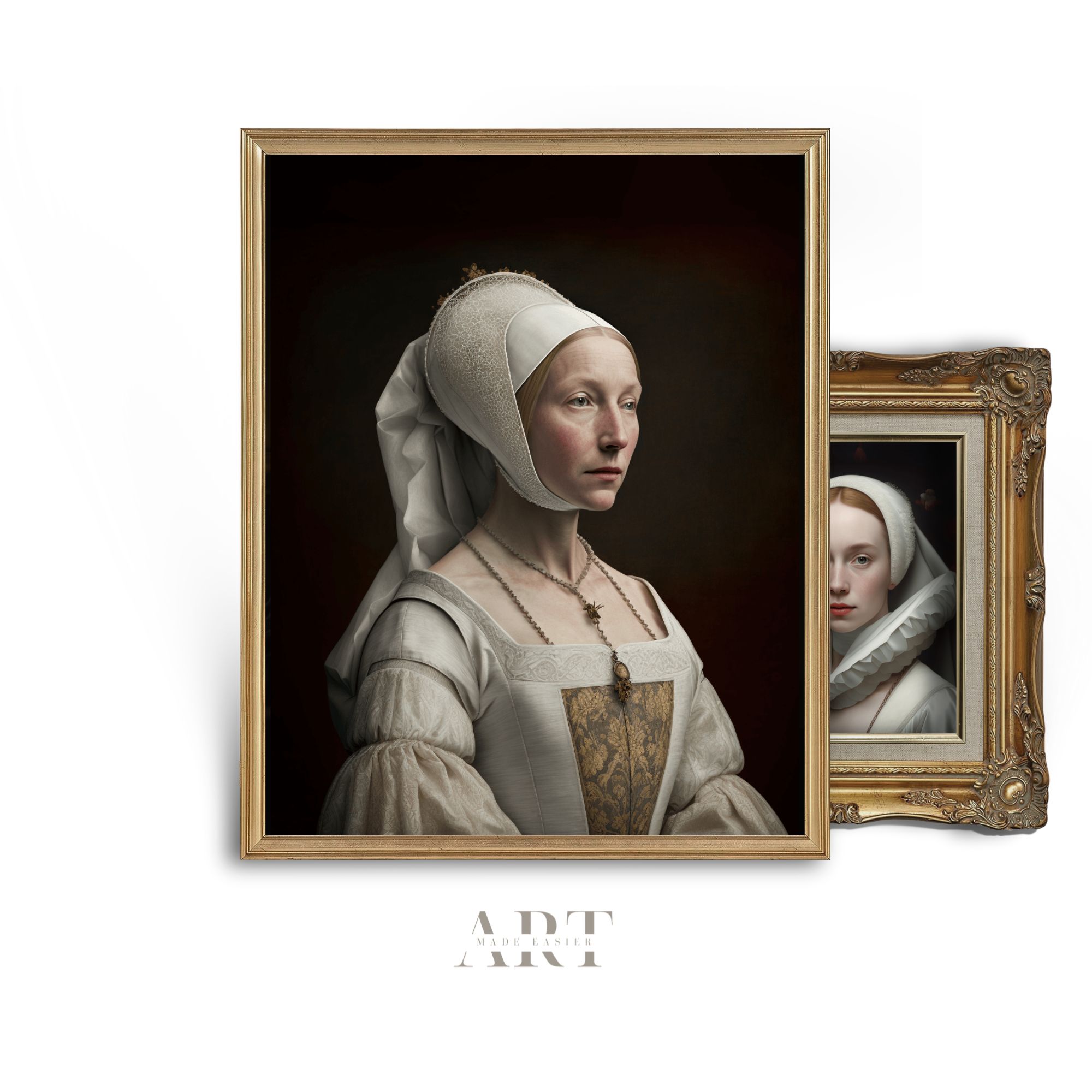Swedish Antique Mirrors
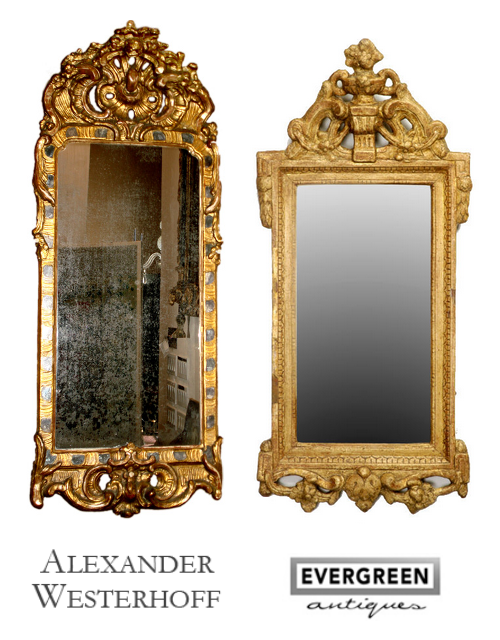
Period 18th Century Danish or Swedish Mid-18th Century Pier Mirror
A small Swedish Gustavian giltwood mirror, Late 18th Century
Swedish mirrors have undergone a number of styles since they were introduced in the country in the 1600s.
German glass makers helped to lead the way, and they created mirrors in the baroque style of their home country. This included carved frames and a single pane of glass. Carvings could be simple or ornate, and frames could be square or rectangle, as seen in this mirror From Cupboards and Roses
Mirrors could also be made more ornate by hanging a curtain over them. This added a bit of flair and formality to the mirror.
A century or so later, more people began acquiring mirrors and the style switched to that of Swedish Rococo. This style featured carvings of shells or arabesques, and the frames were gilded and asymmetrical.
Shortly thereafter, another style evolved. The Gustavian style saw mirrors that were influenced by neoclassical aesthetics. Frames were richly carved and featured intricate leaves, ribbons and crests.
These neoclassical mirrors feature a pair of sphinxes on each mirror on either side of a fruit-bearing
pedestal.
By the early 19th century, the aesthetic was changing again. Roman and Egyptian influences made themselves known, and mirrors featured carvings of things such as lions, sphinxes, and griffins. The frames also took on a distinctive shape, with semi-circular domes at the top and straight edges along the bottom.
This Swedish pier mirror, shows neoclassical details inspired by Napoleon’s Egyptian campaign.
By the middle of the century, mirrors became much more common in everyday households, and production methods became more base. Decoupaged frames became common, or they were veneered.
The style evolution of Swedish antique furniture mirrors was influenced by a number of factors, and it produced some gorgeous mirrors that make excellent collector’s items now.
What is your favorite style of Swedish antique furniture mirror? Share your thoughts or your finds in the comments!
About the Author:
Alexis Bonari writes for one of the largest open databases of college funding opportunities. Specific topics like scholarships for cosmetology school are described in detail to provide multiple resources for students.
Swedish Transition Rococo/ Gustavian Mirror
Turn Of The Century Apartment In Sweden- Interior Design Files
This fine Swedish Adolf Fredrik period rococo gilt wood mirror has carved C-scrolls and foliate motifs.
Swedish Rococo Mirror with gold leaf on wood carved frame and a mirrored
inner frame. Stamped NM (Niklas Meunier), active between 1754-1797.
Parlor Table Gustavian Style
Wedding at Trollenas Castle (Trollenäs Slott) in southern Sweden
Swedish neoclassic console and mirror. The console having a veined white marble top above a frieze with carved foliate motifs and a central medallion, sitting on tapered fluted legs.The rectangular mirror having a plate within a robed border surmounting a rectangular top crest and medallion within foliate ribbon.
de Gournay Wallpaper
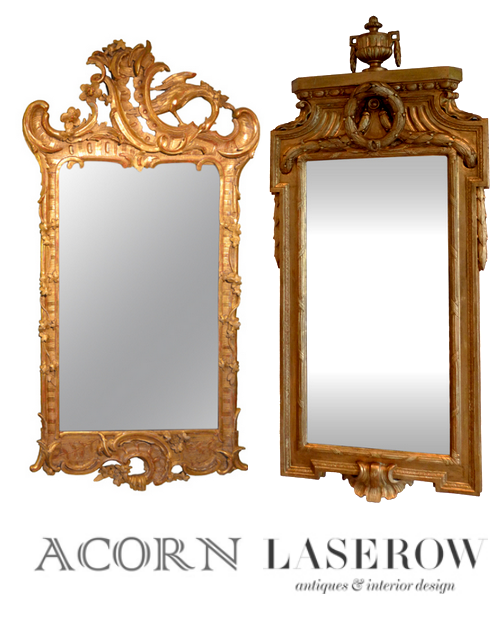 Danish Rococo Mirror 1750– Dietrich Schäffer, born 1730 in Keyla, Thuringia – died 1778, was a German Royal Court carpenter employed at the Danish Court in Copenhagen in the 18th Century. He was one of the main Rococo furniture artists of the time.
Danish Rococo Mirror 1750– Dietrich Schäffer, born 1730 in Keyla, Thuringia – died 1778, was a German Royal Court carpenter employed at the Danish Court in Copenhagen in the 18th Century. He was one of the main Rococo furniture artists of the time.
Lars Sjöberg and his Swedish manor Ekensberg- World Of Interiors Fall 2008
A Swedish Rococo gitwood mirror, Third Quarter 18th Century, the divided mirror plate surrounded by a molded giltwood frame with a beveled glass panel, surmounted with a pierced shell, foliate and scrolled crest, the lower section with similar carving.
A Superb Swedish Rococo Gold Gilt Mirror circa 1760
Swedish Interiors- Originally Uploaded From Kristin Fägerskjöld on Pinterest
French Directoire Period Giltwood Trumeau Mirror-A petit French Directoire period giltwood trumeau mirror with sheath of wheat cartouche and other neoclassical detailing (Circa 1790). Nice old mercury glass.
Petit Louis XVI Period Giltwood Trumeau Mirror-A petit French Louis XVI period giltwood mirror with a pair of doves and wreath cartouche, laurel leaves and other neoclassical detailing, and nice old mercury glass (“trumeau de marriage”) (Circa 1780).
Swedish Interiors- Originally Uploaded From Kristin Fägerskjöld on Pinterest
Gustaviansk crested with wheat signed Johan Åkerblad, Stockholm circa 1760- Gustavian Mirrors
Quiet luxury inspired by 18th-century Sweden
Light - Patina - Heritage

Restoration Tools
- Matte Topcoat
- Pro Grade Brush Set
- Finishing Sealer In Matte
- Bronze Spray For Hardware
- Sticks To Everything Primer
- Dead Flat Varnish
- Stick To Everything - Matte Primer
- Transparent Aged Glaze
- Sticks To Everything Brown Primer
- Prima Transfers
- Dyke Brown Glaze
- Escutcheons
- Medallion Silicone Mold
- French Key Molds
- Portico Scroll
- Rusty Paint Finishes
Recent Posts
- 200 Swedish Antiques A Person Can Look For
- Rococo In The Nordic Countries
- For The Love Of Collecting Antiques – A Swedish Interior
- Gustavian Furniture – How to get the look – Ulla Kloster
- 3 Swedish Must Haves – Decorating A Home Around Swedish Antiques
- The Beautiful Wall Paintings Of von Echstedtska gården In Sweden
- 400 Professional Designers Picked Green As The New Color To Watch
- 5 Scandinavian Interior Design Tricks – Megan Slack
- 30 Gray Toned Paint Colors For Swedish Styled Interiors – Behr
- DIY Upper Kitchen Cabinets – Lindsay – White Buffalo Styling
- Bringing The Garden In For The Winter
- The Home Office – Why Not Make Yours Unique ?
- The Light And Airy Furniture Of Sweden
- Slipcovers Have Always Been Popular Through Time – Swedish Decorating
- The Couple Behind D. Larsson Interior and Antikhandel – Swedish Antiques
- 6 Colors You’ll Find In Every Scandinavian Home – Laura Barry
- 5 Decorating Mistakes Not To Make – By Gabrielle Savoie
- Designer Marshall Watson’s Scandinavian Newport Beach Home
- Designer Marshall Watson’s Scandinavian Summer House
- Swedish Inspired Kids Bedrooms
- 5 Kitchen Design Lessons You Can Learn from Scandinavian Interiors
- Jenny’s DIY Wide-Plank Plywood Flooring Studio Renovation
- Decor Mistakes All 20-Somethings Make
- Can I Stain Over Paint To Produce A Patina?
- Q&A With Swedish Designers Edie Van Breems and Rhonda Eleish
- How To Avoid Yellowed White Painted Furniture With General Finishes Products
- Colleen Martin, Founder of Swede Collection Tells Us Her Journey Of How She Began Reproducing Gustavian Furniture
- Expect To See More Warm Grays, Blues And Creams In Gustavian Decorating
- 8 Brands Of Gold Spray Paint Were Compared To Find The Best Color
- Essential Characteristics Of 18th Century Swedish Interiors
- Gustavian Style By Kristie Barnett
- 7 Places To Find Swedish Design For Toddlers
- Study Shows The Gustavian Period Has Defined All Tastes Through Time In Sweden
- Mix Old and New Like the Scandinavians Do- Chloe Taylor
- Swedish Furniture Design – What Makes The 1800’s So Obsessive
- 5 Pieces Of Wise Decorating Advice From Tricia Foley
- Impressive History Of Fine Swedish Table Linen
- Linen Has An Incredible History- Find Out Why……
- Life In 17th Century Norway & Sweden
- How To Select The Right Linen For Your Children’s Bedroom- Kids Room Decor Ideas
- Nordic Style Kids Bedroom Decor Ideas
- Decorator Tricia Foley’s Signature White Interiors
- 10 Tips From Interior Designer Furlow Gatewood
- Living In Norway- Norwegian Life In The 18th & 19th Centuries By Elisabeth Holte
- Investing In Mora Clocks – Expert Advice From Jo From Swedish Interior Design
- International Interior Decorating Magazines Worth Buying
- Swedish Council Of America Articles
- 5 Homes Decorated Around The Nordic Style
- Swedish Reproduction Furniture At Solgarden
- Behind The Rundale Palace in Latvia
- Nordic Style Historical Interior Decorating Books – Living Museums in Scandinavia
- Decorating Around Red- Historical Interior Design Ideas
- Florence De Dampierre Comments On Nordic Furniture In Sweden And Denmark
- 12 Designers Pick Their Favorite Paint Colors – House Beautiful
- 7 Of The Most Famous Swedish Furniture Designers And Decorators
- New Research Suggests Swedish Furniture In The 1700’s May Have Had Strong Colors
- Swedish Tripod Tilt-Top Candle Stand Tables
- Decorators Who Have Embraced The Nordic Style – 30+ Pictures
- A Look Behind Skogaholm Manor -18th century Swedish Decorating
- Decorating With Swedish Country Antiques- Darlene Peterson Buchanan
- 12 Interior Designers Pick Their Favorite Swedish Paint Colors
- 50+ Decorating Books Worth Looking At
- Swedish Decorating Inspirations In Yellow, Ivory And Beige- 50+ Pictures
- Decorating Around The Color Green – Swedish Style
- A Dallas, Texas Home Decorated Around The Swedish Style
- 3 Houses Decorated Around The Rustic Swedish Style
- Reproduction Distressed Furniture And Home Decor From Bliss Studio
- Buy The Swedish Style For Less
- 3 Swedish Style Homes Featured In Magazines
- Swedish Antiques From Debenham Antiques
- The History Behind Jean Bernadotte Otherwise Known As Karl Johan
- 5 Faux Wall Painting Techniques That Are Easier Than You Think
- Swedish Kids Rooms: 6 Ideas To Get The Look
- 5+ Nordic Homes Decorated Around White
- 10 Of The Best Tours In Sweden
- 3 Rustic Scandinavian Country Homes – Borrow Ideas From Norway and Denmark
- Spring Summer Checks and Florals For The Swedish Home
- 70 Swedish Furniture Pieces That Sell For Less- Swedish Decorating On A Budget
- Decorating With Blue: Swedish Style Decorating Ideas
- An Interview With Daniel Larsson- The Go-To Guy For Swedish Antiques
- 7 Scandinavian Country Decorating Books
- 75 Swedish Nordic Pinterest Pages! Oh Yes…More Eye Candy!
- 69 Inspiring Pictures Of Nordic Country Style Decorating
- 20 Scandinavian Gift Ideas
- 5 Ways To Add Life Into Worn-Out Furniture
- Mora Clocks: Investing In Swedish Heritage
- How To Decorate With Botanicals
- Buying Property In Sweden
- Get The Swedish Look By Installing Tongue And Groove Paneling
- The Lavish Interior Of The Swedish Häringe Castle
- The Swedish Wreta Gestgifveri Inn
- Paint It White He Says…. Washington Interior Designer Darryl Carter – Swedish Decorating
- 5 Pro Painting Tips For Black Furniture
- The Swedish Artist Carl Larsson
- A Guesthouse Decorated in The Swedish Style
- Swedish Furniture From Bukowski Market
- 216 Selections From Wallpaper Direct – Swedish Decorating
- A Look Behind The National Museum of Stockholm
- Antique Swedish Dealer Jane Moore’s Home Veranda Magazine
- A Swedish Collected Home In Upstate New York – Swedish Gustavian Decorating
- $100+ Solid Braided Rugs
- 60 Scandinavian Country Folk Art Books On Amazon
- 50 Examples Of Swedish Folk Country Interiors
- Designers Pick Their Favorite Gray Paints
- HOW TO: Paint Gustavian Finishes
- “Söderbo” A Home Untouched Since 1920
- Designer Martha Angus Loves Gustavian Style
- Les Indiennes Fabrics
- Decorating Secrets- 60 Quotes From The Best Experts In Design
- Swedish Kakelugn Stoves
- Helen Olsen’s Rungstedlund Home Revealed In Gods & Gardar Magazine
- The 1700 Collection Swedish Furniture
- Swedish Plaster Medallions
- The History Behind Empire Furniture From The Karl Johan Period -Liza Laserow
- Swedish Styled Wallpaper
- Nordic Style Drapery And Window Coverings
- The Gentle Palette of Swedish Antiques-Corey Amaro
- Custom Reproduction Swedish Furniture From Garbo Interiors
- 30 Spectacular Picks From Frantz Hemeleers Antiques
- Go Bold With Red- Part 1 Grand Sophisticated Interiors
- Go Bold With Red- Nordic Country Interiors
- The Baroque Style Of Switzerland
- Daniel Romualdez’s Swedish Montauk Home
- The Shocking History Behind “Emerald Green” Paint
- Stylish Looks For Slip-covering Your Furniture
- The Best 5 Websites For Purchasing Antique Hardware
- Fired Earth’s Anniversary Paint Collection
- Swedish Furniture Auctions -Uppsala Auktionskammare
- Louis Masreliez- The Designer Behind Gustav III’s Pavilion At Haga Park
- A Nordic Design Staple- The Swedish Kakelugn Tile Stove
- Swedish Antique Mirrors
- How To Decorate A Child’s Room In The Swedish Style
- Ruby Beets Swedish Rustic Home
- The Country Side Of Sweden- An All White Based Home
- Akerö in Södermanland, Sweden
- Krusenberg Herrgård: An 18th Century Swedish Luxury Hotel
- Wood Plank Flooring, A Swedish Design Must Have – Part 1
- Vinyl Plank Flooring, A Swedish Design Must Have – Part 2
- Laminate Wood Flooring, A Swedish Design Must Have – Part 3
- Plywood Plank Flooring, A Swedish Design Must Have – Part 4
- Painted Wood Flooring, A Swedish Design Must Have – Part 5
- The Romantic Baroque Style: Part 1- Stromholm
- The Romantic Baroque Style: Part 2 King Gustav Vasa
- The Romantic Baroque Style: Part 3 Skokloster & Steninge Palace
- The Romantic Baroque Style: Part 4 – A Collectors Home
- The Romantic Baroque Style: Part 5 Add Color
- Sweden’s Empire Decorated Rosersberg Palace
- The Most Beautiful Rococo Library In The World:The Anna Amalia Library
- 4 Resources For Swedish Decorating
- How Important Are Accent Pieces In A Swedish Home?
